| Review: WARM CARDS - White Balancing System |
February, 2006

WARM CARDS - White Balancing System
www.warmcards.com
$65.00
Review by Bob Gladden and Steve Douglas
Anyone who uses
a digital camera, being it a still camera or a video camcorder
will want to set his/her white balance. Often much time is spent
setting up a shot, trying to achieve that "special signature
look" that is either characteristic of our style of shooting
or desired by the client. Sometimes we use filters, special lights,
and mattes or a combination of these to try and get an image
with a special feel. One thing that will truly affect every shot
is the setting of the white balance.
Light changes frequently; from
bright sun to shade, our eyes adjust automatically, but the digital
cameras and camcorders that we use, whether they have CCD's or
CMOS chips in them, don't make these adjustments quite so efficaciously.
They need a reference point. Thus they use a white balance setting
to achieve this. Almost all digital camcorders have Automatic
White Balance (AWB) and most have a Manual White Balance setting
as well.
In Automatic White Balance mode
your camera looks at the overall image and calculates the best
white balance setting. While the automatic white balance mode
often works pretty well, it can make mistakes. These errors may
sometimes be repaired during color correction in post but it
is best to avoid the problem in the first place. "White
color" is a combination of all colors put together. White
balance needs to be changed manually to obtain optimum color
and results.
To find out how well your camera
works in AWB mode, set your camera to its AWB setting and take
some photos/video of the same subject under different lighting
conditions. Study your results. Compare them to the same shots
where you have manually white balanced before taking the shot.
If your results using the AWB are within a range you feel comfortable
with, than use the AWB for that situation. However, I am confident
that you will see a marked improvement in the color saturation
and hue in clips shot with a manual white balance setting. White
balance may be the key to every shot, and having a consistent
white balance is the key to bringing a consistent look to your
sequence or film. Relying on the "auto white balance"
in every situation, and in changing conditions may be a mistake.
The auto white balance in the camera is a default setting and
does not take into account the different lighting conditions
- outdoors to indoors, bright sun to shade, lighting from different
angles and from a variety of light sources such as fluorescent,
tungsten and a host of other types. While it may work just fine
in certain circumstances, Auto white balance has a tendency to
wash out and remove depth from the colors. Setting the white
balance manually, and setting it consistently tells the camcorder
how to set other colors based on that WHITE reference.
Resetting your white balance in changing conditions and locations
with the same white reference allows you keep the same desired
appearance throughout your production.
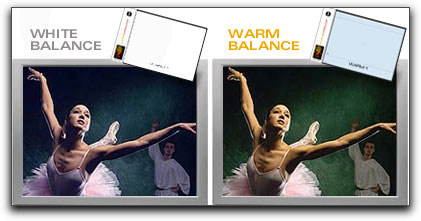 |
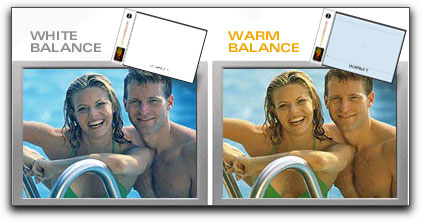 |
Most cameramen love the warm, beautiful
images, which film gives to a production. Video is not film.
Digital video cameras provide images that seem to be somewhat
harsher and cooler than what our eyes perceive. To get those
colors back, we trick the camcorder into accepting a white balance
that provides for better coloration. Using a white card is a
common way to set your white balance. But is your white balance
set the same every time you set it? If you use the same card
each time, than yes, your white balance will be consistent. But
if you don't than your white balance will vary with the different
white cards/papers (shades of white), or whatever it is that
you may be using. This in turn will affect the coloration of
your images. The standard white of a white balance card should
be 100 IRE. This is the standard used in the photographic/film/video
industry for white.
Warm Cards
are an easy way to provide a warming, more natural look to your
productions. The beautifully crafted cards come packaged in a
sturdy leatherette zippered pouch for protection and carrying,
and include 3 full-size 6" X 10" cards of different
grades or strengths and 3 pocket size 3"X4" mini-cards
in matching grades. Each card, additionally, has markings for
use with both 16X9 and 4X3 aspect ratios. All the cards are waterproof,
sturdy and held up very well in the field. In the case of this
review that meant underwater where all kinds of salt and other
elements could have destroyed a card of lesser quality manufacturing.
Each Warm card has a nicely matted finish to avoid unwanted reflections
while white balancing and is grommeted for easy organization
and carrying.

The Warm Cards, in their "Standard
Pack" come in three different levels of light blue. (Warm
1, Warm 2, Warm 3.) Pure white light (sunlight, 6000KÉ)
gives everything a bluish cast. That is why there are different
levels of Warm Cards. Depending on the conditions you are shooting
in and the look you are trying to achieve, one of these cards
will provide you with what you want. Just imagine that you are
shooting an interview on a tropical island. It is a beautiful,
cloudless day, the sun shining bright and harsh overhead. In
this case you may want to use a Warm #3 card to set your white
balance with. This will counter the bright harshness, providing
more natural looking skin tones to your subject.
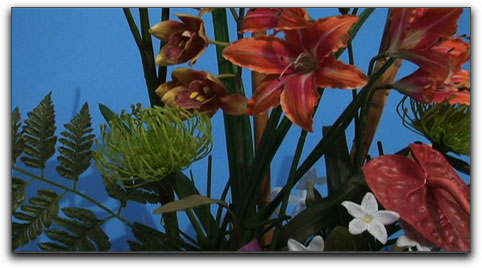
There is also an optional "Plus
Pack" that comes with two other cards, (Warm 1/2 and Minus
Green). These cards are of the same high quality as the others
but add a greater arsenal to your white balancing abilities.
The Warm minus card is one half the level of the Warm 1 card;
the Minus Green card is for shooting under fluorescent lighting,
eliminating the greenish cast that cameras often capture without
it.
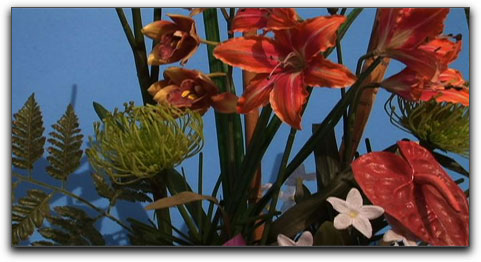
Warm Card 1
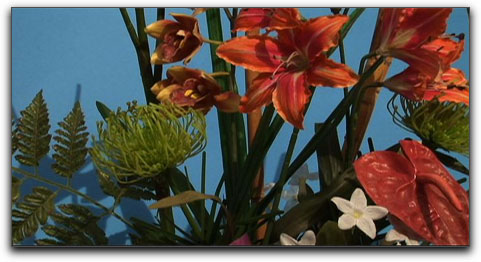
Warm Card 2
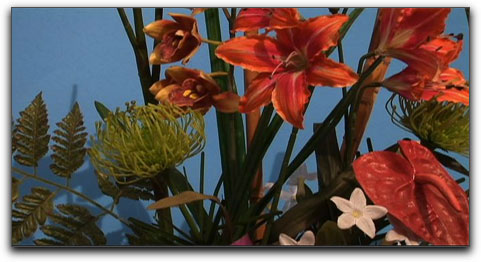
Warm Card 3
Using Warm Cards will give you
the consistency between shots, between locations (both indoors
and outdoors), and when using multiple cameras. Warm Cards are
all standardized (they all have the same shade / level of blue
on every set of cards); therefore you can always be confident
that you have balanced each shot correctly.
Warm Cards are not white, but levels
or grades of light blue. When a camcorder sees a light blue color
and you set your white balance to it, it shifts the colors to
a warmer range. The camcorder sees the light blue color as "white",
eliminating that shade of blue and shifting the whole range of
colors making them warmer. In addition, having consistency of
white balance makes it much easier to match shots in postproduction,
where you will do far less color correcting. This, in turn, is
a big asset if you are on a tight time line for the finished
production.
I use my Warm Cards on my underwater
productions. They produce a more realistic image. As soon as
you go below the surface the light changes and you start to lose
colors (mostly in the red range). Light and color is absorbed
with increasing depth. Using Warm Cards gave me a more consistent
white balance even when used with underwater lights. The Warm
colors have definitely helped to bring out the colors of the
fish and the skin tones of the divers. They simply looked more
natural, avoiding that washed out appearance I sometimes notice
when shooting underwater. However, underwater, your white balance
needs to be reset every time you change depth or whenever the
lighting conditions change. The important thing is that Warm
Cards really did the job and held up to a greater stress than
most shooters normally would have ever applied to them.
Warm Cards were very easy to use.
You just hold the card you have chosen in front of the camera,
zoom in until the card fills the screen and set your white balance.
When conditions change, or you change locations or lighting just
reset your white balance again with the same card and start shooting.
After you have tried everything
else to get your white balance the way you want you will be more
than happy with your purchase of Warm Cards. They are inexpensive,
durable and will help you to achieve what you and your clients
expect from quality shooting. Bottom line on the Warm Cards?
I have no intention of ever again traveling to a shoot without
them.
Steve Douglas is an underwater videographer and contributor to numerous film
festivals around the world. A winner of the 1999 Pacific Coast
Underwater Film Competition, 2003 IVIE competition, 2004 Los
Angeles Underwater Photographic competition, and the prestigious
2005 International Beneath the Sea Film Competition, Steve has
also worked on the feature film "The Deep Blue Sea",
contributed footage to the Seaworld parks for their Atlantis
production, and is one of the principal organizers of the San
Diego UnderSea Film Exhibition. Steve leads both underwater filming
expeditions and African safaris with upcoming filming excursions
to Kenya, Bali, the Philippines, and the Red Sea. Feel free to
contact him if you are interested in joining Steve on any of
these trips. www.worldfilmsandtravel.com
Bob Gladden is a very accomplished diver, underwater
photographer and filmmaker. An underwater photographer for 17
years, his work has been recognized with numerous awards, and
has appeared in publications such as California Diving News,
Discover Diving and Skin Diver. His films have been featured
in local TV newscasts, TV specials and at numerous film festivals.
http://ovisions.com
©Bob Gladden
and Steve Douglas 2006
This article first appeared on www.kenstone.net and is reprinted here
with permission.
All screen captures and
textual references are the property and trademark of their creators/owners/publishers.